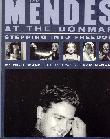SEARCH CurtainUp
REVIEWS
FEATURES
NEWS (Etcetera)
LISTINGSS
Broadway
Off-Broadway
BOOKS and CDs
OTHER PLACES
Berkshires
London
Los Angeles
Philadelphia
Elsewhere
QUOTES
On TKTS
LETTERS TO EDITOR
FILM
LINKS
MISCELLANEOUS
Free Updates
Masthead
NYC Weather
The Crazy Locomotive
By Jenny Sandman
|
For people nowadays, the…[art] forms of the past are too placid, they do not excite their deadened nerves to the point of vibration. They need something that will rapidly and powerfully shock [them]…and act as a stimulating shower after long hours of stupefying mechanical work. --- Witkiewicz |
Witkiewicz in Harlem? Only in New York.
A prominent member of the early twentieth-century Polish avant-garde, Witkiewicz was also an artist, a drug addict, and probably clinically insane. In his essay ""Theatre: An Introduction to Pure Form," Witkiewicz stated that theatre should be like an insane asylum or a madman's brain onstage. In 1921, he developed his own theory of realities; he stated that there was no single, uniform reality, but in fact four different ones that produced four different kinds of art. That same year, he wrote his first play, Tumor Brainowicz, in which the hero is very much like Einstein. He declared it "a fantasy on the theme of the revolution in mathematics and physics." Unfortunately, it gave him a reputation for lunacy that he would never overcome--the critics were scandalized. It was called "an unnatural clinical abortion [which]…should be put in alcohol and studied by psychopaths." It was not staged again until 1975.
To modern audiences, Witkiewicz's plays aren't so strange. They're very akin to the works of Richard Foreman or the Wooster Group, full of inconsistent psychology and logic, chronological and spatial anomalies; his plays are discontinuous, and juxtaposed, constantly shifting and changing, meant to shock placid audiences into awareness. If you've seen anything at P.S. 122 or The Flea (where I recently reviewed another Witkiewicz play-- see link below), Witkiewicz will not be difficult.
Written in 1923, first performed until the '60s and only 45 minutes long, The Crazy Locomotive is the story of two engineers and the woman they both love. As they push the locomotive to ever-greater speeds, they discover the woman, Julia, who has stowed away. They both proclaim their love, woo her, fight each other, and reveal their true identities as arch-criminals. They keep pushing the train, until a head-on collision with another train is inevitable. The train is destroyed, the passengers thrown or dead.
It is an eerily Einsteinian play; time and space are mangled as the locomotive speeds out of control. Perhaps not coincidentally, Einstein used trains to explain relativity in layman terms. Witkiewicz capitalizes on this idea of using a train to illustrate a scientific concept to confront mechanization and the acceleration of life directly; the machine is a metaphor for madness, for the inevitable quick movement toward entropy and death. The characters use the acceleration of the train to escape from their boring lives. They speak of being adrift in space, isolated, cut off from reality, of their breakneck speed through the "cosmic abyss." They also discuss the theory of relativity; "We're not only rushing through space, we're intensely aware of it…And that's why the scientific view of relativity can never correspond to reality!"
Classical Theatre of Harlem's production is as futuristic and surreal as the plot suggests. The set is an intricate shell of machinery with many levers and ribs and buttons and flaming pits. It looks like the inside of a steel factory, or like something out of Metropolis. All the appropriate flame and steam sound effects are represented, with the occasional faraway crackle of an unintelligible railway announcement. It is a marvel of set design, perfectly filling the cavernous stage with an equally cavernous locomotive. The three principal actors (Alfred Preisser, Leopold Lowe, and Erica Ball as Julia) are lively, perfectly echoing the train's exhilarating, headlong rush to freedom, and they buzz with an unmistakable chemistry.
It's almost a shame the play is so far uptown; I imagine there will be many people who miss it, simply to avoid the neighborhood. But don't make that mistake--not only is the theatre less than a block from the subway, it's a mesmerizing production of a play that is very rarely produced. And by a mad genius-how often does that happen? LINKS
The Blacks: A Clown Show-- another recent Classical Theatre of Harlem review
Another recently reviewed Witkiewicz play
|
THE CRAZY LOCOMOTIVE Written by Stanislaw Witkiewicz Directed by Christopher McElroen Featuring Alfred Preisser, Leopold Lowe, Erica Ball, Maria Oliveras, Ross Williams, Michael O'Day, Marissa Tiamfook, Roland Garcia, Yves Rene, Roger Hendricks Simon and Dan Hendricks Simon Set and Costume Design by Anne Lommel Lighting Design by Colin Young Sound Design by Stefan Jacobs Running time: 45 minutes without intermission Classical Theatre of Harlem At Harlem School of the Arts, 645 St. Nicholas Ave at 141st Street 212-206-1515; $15 Through April 20; Thursday through Saturday at 8 PM, Sunday at 3 PM Reviewed by Jenny Sandman based on April 13th performance |

Mendes at the Donmar
Our Review

At This Theater

Leonard Maltin's 2003 Movie and Video Guide

Ridiculous!The Theatrical Life & Times of Charles Ludlam

Somewhere For Me, a Biography of Richard Rodgers

The New York Times Book of Broadway: On the Aisle for the Unforgettable Plays of the Last Century

6, 500 Comparative Phrases including 800 Shakespearean Metaphors by CurtainUp's editor.
Click image to buy.
Go here for details and larger image.



